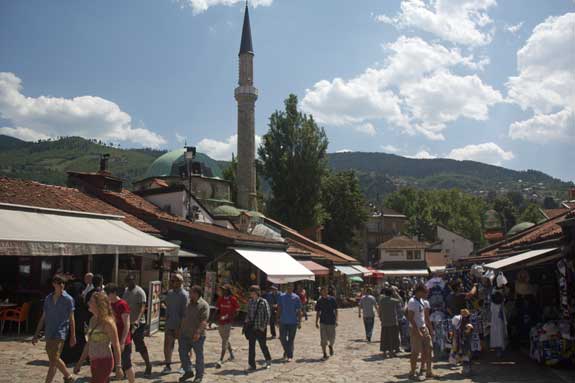Monday Escape: Sarajevo, Bosnia and Herzegovina

If you are old enough to remember the 1990s wars after the break up of Yugoslavia, chances are good that you remember Sarajevo as the center of the violence. Well, the conflicts have now been settled for well over a decade, and Sarajevo is completely safe and quite fascinating, only partly because it was the flashpoint.
The biggest challenge that most people have these days in visiting Sarajevo is that it’s well off the beaten path. It does have its own international airport, of course, but flights tend to be expensive. Those touring around Europe by train will find that this is part of the continent where trains are slower than buses, and it’s a long way from everywhere. Still, if you make the effort, Sarajevo is definitely worth a stop.
The vibe in Sarajevo
Without getting into the famous conflict, the most interesting thing about Sarajevo is that Bosnia had been the Muslim part of Yugoslavia, and that continues today with a large and active mosque in the heart of the city. In fact, the Old Town part of the city is one of the most charming and unique in all of Europe, with its Turkish influences still front and center.
It’s a pedestrian-only neighborhood that is lined with shops and restaurants the whole way through, and it’s a simple grid rather than a complicated maze like so many other Muslim towns. Within 100 meters of the mosque is a Catholic cathedral, and an Orthodox cathedral, and even a small Jewish temple. They boast that Jerusalem is the only other place in the world with so much religious diversity in such a small space.
Knowing that the center of town is Muslim might make you assume that it would be very strict, but in fact there are bars and restaurants serving alcohol within steps of the mosque, so the area feels far more inclusive than it otherwise could. People from the Middle East come to Sarajevo for holidays because it’s tolerant of Muslims and allows them to even dress in the full outfit without standing out, and it’s still very European in many ways.
The rest of the city center is similar to other European cities, with your traditional mix of banks and shops and office buildings and such. It might be in a bit more disrepair than most European cities, but this is at least partly due to the damage during the war years. In fact, if you look around for any length of time you are almost certain to notice bullet holes still in the sides of buildings. Evidently many are not being patched as a reminder to what went on.
There are also what they call Sarajevo Roses on some streets and sidewalks, where deadly mortar shells were filled in with a red resin to memorialize those who died there. However, today’s population feels fairly upbeat and is not bogged down in the past, so it’s not a depressing place to visit at all.
The other notable thing about the city’s geography is that it’s nestled between two mountain ranges, so there is very good skiing nearby, and views in both directions tend to be wonderful.
There is plenty of culture and museums to be seen in Sarajevo, though in this case they are probably overshadowed for most people by the unusual mix found in the heart of the city.
The cost of things in Sarajevo
The very good news for those considering visiting this city is that it’s one of the cheapest in all of Europe. With the exception of Croatia’s coastline, all the former Yugoslavia cities are quite inexpensive, but most aren’t nearly so pleasant or interesting.
A hotel room in Sarajevo can start at around US$20 if you are content to stay just a bit outside the city center, or around US$30 for a basic place in the center. Of course it goes way up from there, but that’s still half the price of somewhere like Vienna or even Prague.
Food and drinks are also bargains, with sidewalk pizza available for around US$1.30 for a single serving pie at one notable chain, and not much more at many other places. It is easy to get a complete breakfast or lunch for under US$5 if that’s your goal, and even a dinner at a sit-down restaurant in the city center can start at around US$6 for multiple courses if you choose the local specialties.
Beer is the cheapest drink, and you can get a half-liter of local lager for €1.5 (around US$2) at most places, or a bit more at the posh and trendy bars. Spirits and mixed drinks start in the same price range for local brands, so it can be a cheap party town for those who like a bargain.
